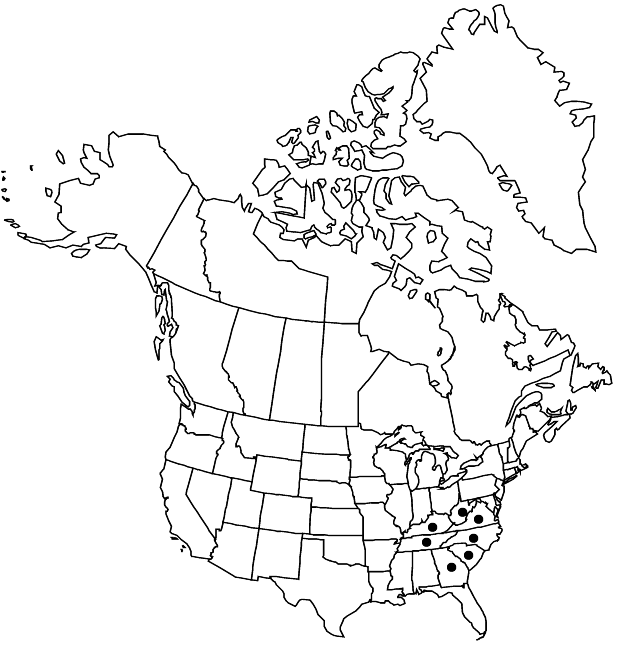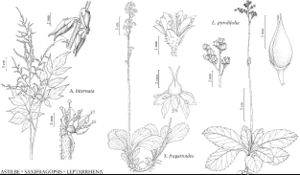Difference between revisions of "Astilbe biternata"
Bull. Torrey Bot. Club 20: 475. 1893,.
FNA>Volume Importer |
FNA>Volume Importer |
||
| Line 28: | Line 28: | ||
|elevation=300-1200 m | |elevation=300-1200 m | ||
|distribution=Ga.;Ky.;N.C.;S.C.;Tenn.;Va.;W.Va. | |distribution=Ga.;Ky.;N.C.;S.C.;Tenn.;Va.;W.Va. | ||
| − | |discussion=<p>Astilbe biternata is known from the southern Appalachian Mountains from Mingo County, West Virginia, through Virginia and Kentucky to the Carolinas, Tennessee, and northwestern Georgia.</p><!-- | + | |discussion=<p><i>Astilbe biternata</i> is known from the southern Appalachian Mountains from Mingo County, West Virginia, through Virginia and Kentucky to the Carolinas, Tennessee, and northwestern Georgia.</p><!-- |
| − | --><p>Elegant when in flower, although rarely cultivated, Astilbe biternata is often confused with goat’s-beard, Aruncus dioicus (Walter) Fernald (Rosaceae), which grows in identical habitats and often side-by-side. Remarkably, both are dioecious with relatively large compound leaves and terminal panicles of relatively small, white, unisexual flowers. Elsewhere in the world, Astilbe species generally have bisexual flowers; Aruncus dioicus is dioecious around the world. Astilbe biternata flowers just after Aruncus, and may be further distinguished by its three-lobed terminal leaflets, glandular hairs, ten rather than 15 stamens, and usually two- rather than three-carpellate fruits.</p><!-- | + | --><p>Elegant when in flower, although rarely cultivated, <i>Astilbe biternata</i> is often confused with goat’s-beard, <i>Aruncus dioicus</i> (Walter) Fernald (<i>Rosaceae</i>), which grows in identical habitats and often side-by-side. Remarkably, both are dioecious with relatively large compound leaves and terminal panicles of relatively small, white, unisexual flowers. Elsewhere in the world, <i>Astilbe</i> species generally have bisexual flowers; <i>Aruncus dioicus</i> is dioecious around the world. <i>Astilbe biternata</i> flowers just after <i>Aruncus</i>, and may be further distinguished by its three-lobed terminal leaflets, glandular hairs, ten rather than 15 stamens, and usually two- rather than three-carpellate fruits.</p><!-- |
| − | --><p>Astilbe crenatiloba has been recognized from the rich, wooded lower slopes of the Tennessee side of Roan Mountain on the North Carolina–Tennessee border as being shorter, with crenate leaves, and fruits to 3 mm long. Although it seems to have distinctive features, it may be just a local variant. It is represented only by its original two herbarium specimens and has not been seen since its discovery, published in 1888, despite repeated searches.</p> | + | --><p><i>Astilbe</i> crenatiloba has been recognized from the rich, wooded lower slopes of the Tennessee side of Roan Mountain on the North Carolina–Tennessee border as being shorter, with crenate leaves, and fruits to 3 mm long. Although it seems to have distinctive features, it may be just a local variant. It is represented only by its original two herbarium specimens and has not been seen since its discovery, published in 1888, despite repeated searches.</p> |
|tables= | |tables= | ||
|references= | |references= | ||
| Line 54: | Line 54: | ||
|publication year= | |publication year= | ||
|special status= | |special status= | ||
| − | |source xml=https://jpend@bitbucket.org/aafc-mbb/fna-data-curation.git/src/ | + | |source xml=https://jpend@bitbucket.org/aafc-mbb/fna-data-curation.git/src/8f726806613d60c220dc4493de13607dd3150896/coarse_grained_fna_xml/V8/V8_258.xml |
|genus=Astilbe | |genus=Astilbe | ||
|species=Astilbe biternata | |species=Astilbe biternata | ||
Revision as of 18:05, 18 September 2019
Leaves coarse, terminal leaflets usually 3-lobed, or at least 2-lobed, even if weakly or unevenly; petiole, rachis, and petiolules usually stipitate-glandular. Leaflets petiolulate; blade ovate, 8–15 × 4–15 cm, base usually cordate, rarely cuneate, margins sharply serrate to crenate, apex acuminate. Flowers: sepals persistent, triangular, 0.7–1.5 mm; petals 5 or absent in pistillate flowers, erect, spatulate to subulate, 1.5–4 mm. Capsules partly connate, or separating as 2 follicles, 3.5–4 mm. Seeds 5–10, linear, 1.5–2 mm. 2n = 28.
Phenology: Flowering Jun.
Habitat: Rich woods and shaded north-facing road banks, ditches and seeps
Elevation: 300-1200 m
Distribution

Ga., Ky., N.C., S.C., Tenn., Va., W.Va.
Discussion
Astilbe biternata is known from the southern Appalachian Mountains from Mingo County, West Virginia, through Virginia and Kentucky to the Carolinas, Tennessee, and northwestern Georgia.
Elegant when in flower, although rarely cultivated, Astilbe biternata is often confused with goat’s-beard, Aruncus dioicus (Walter) Fernald (Rosaceae), which grows in identical habitats and often side-by-side. Remarkably, both are dioecious with relatively large compound leaves and terminal panicles of relatively small, white, unisexual flowers. Elsewhere in the world, Astilbe species generally have bisexual flowers; Aruncus dioicus is dioecious around the world. Astilbe biternata flowers just after Aruncus, and may be further distinguished by its three-lobed terminal leaflets, glandular hairs, ten rather than 15 stamens, and usually two- rather than three-carpellate fruits.
Astilbe crenatiloba has been recognized from the rich, wooded lower slopes of the Tennessee side of Roan Mountain on the North Carolina–Tennessee border as being shorter, with crenate leaves, and fruits to 3 mm long. Although it seems to have distinctive features, it may be just a local variant. It is represented only by its original two herbarium specimens and has not been seen since its discovery, published in 1888, despite repeated searches.
Selected References
None.
